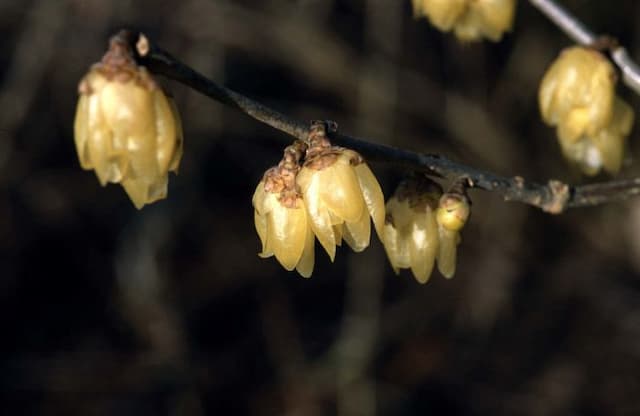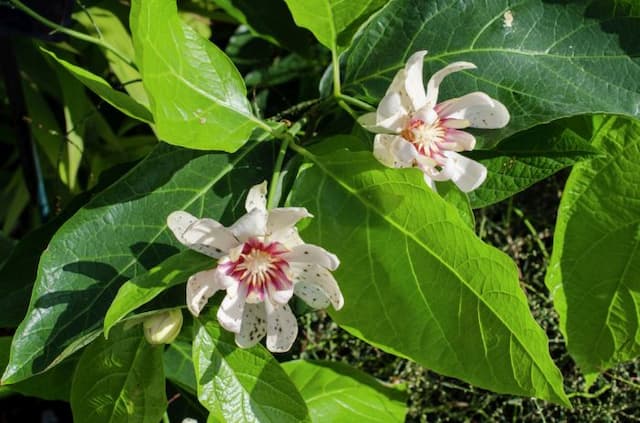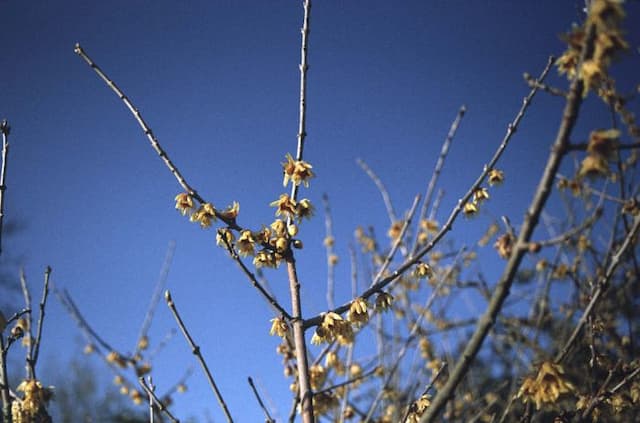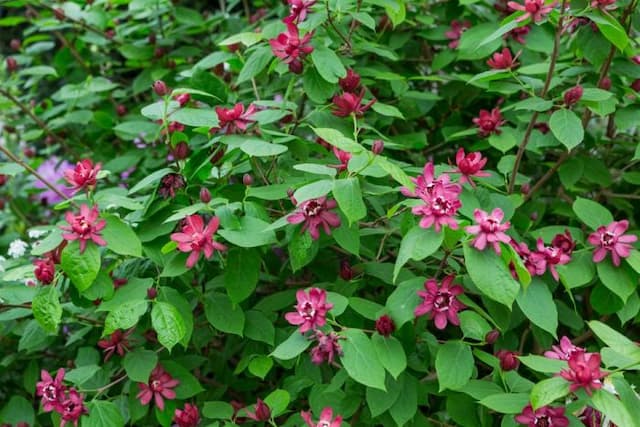Wintersweet Chimonanthus praecox

ABOUT
Chimonanthus praecox, commonly known as wintersweet, is a deciduous shrub renowned for its highly fragrant flowers which blossom in the winter and early spring months. The plant bears a profusion of pendulous, yellow blooms, often with a purplish center, which exude a sweet and strong perfume that can fill the surrounding air. The flowers are composed of numerous strap-shaped petals, giving them an almost waxy appearance. Wintersweet leaves are simple, oblong, and have a leathery texture with a pointed end and a smooth margin. The foliage is a rich green color, creating a beautiful contrast with the wintertime blossoms. After flowering, the plant produces inconspicuous fruit that is dry and woody. Wintersweet's branches are structured in a way that, when devoid of leaves during the dormant season, still provides visual interest due to the flowers emerging directly from the bare stems.
About this plant
 Names
NamesFamily
Calycanthacee
Synonyms
Wintersweet, Japanese Allspice, Winter Sweet.
Common names
Meratia praecox, Calycanthus praecox.
 Toxicity
ToxicityTo humans
Wintersweet (Chimonanthus praecox) is not commonly known to be toxic to humans. There is limited information on the toxicity of this plant, and it does not typically appear on lists of poisonous plants. However, as with any plant, individual allergies or sensitivities can occur, so it is always wise to handle plants with care and avoid ingesting parts of ornamental plants unless they are known to be edible.
To pets
Wintersweet (Chimonanthus praecox) is not widely recognized as a toxic plant to pets including cats and dogs. There is limited documentation regarding its potential toxicity, and it is not commonly listed among plants that are known to be poisonous to household pets. Nonetheless, the general rule of thumb is to prevent pets from ingesting plants that are not meant for consumption, as they could potentially cause gastrointestinal upset or an allergic reaction in sensitive animals.
 Characteristics
CharacteristicsLife cycle
Perennials
Foliage type
Deciduous
Color of leaves
Green
Flower color
Yellow
Height
10-15 feet (3-4.5 meters)
Spread
6-8 feet (1.8-2.4 meters)
Plant type
Shrub
Hardiness zones
7
Native area
China
Benefits
 General Benefits
General Benefits- Aesthetic appeal: Chimonanthus praecox, also known as wintersweet, is known for its fragrant, pale-yellow flowers that bloom in winter, providing visual interest during a typically barren season in many gardens.
- Winter flowering: Wintersweet flowers at a time when few other plants do, offering a valuable nectar source for pollinators that are active during the cooler months.
- Fragrance: The blossoms emit a strong, sweet fragrance that can scent an entire garden, making it a favorite among gardeners for its aromatic qualities.
- Cut flowers: The flowers of wintersweet are suitable for cutting and can be brought indoors to decorate and scent the home.
- Historical significance: Wintersweet has a long history of cultivation in China and is often associated with traditional Chinese gardens, providing cultural and historical value.
- Drought resistance: Once established, wintersweet is relatively drought tolerant, making it suitable for gardens with less water availability.
 Medical Properties
Medical Properties- Analgesic: Reported use in traditional medicine to alleviate pain.
- Anti-inflammatory: Used to reduce inflammation in certain traditional healing practices.
- Antipyretic: Historically used to lower fever.
- Expectorant: Believed to help in expelling phlegm from the respiratory tract.
- Astringent: May be used to contract the skin and mucous membranes, reducing secretions.
 Air-purifying Qualities
Air-purifying QualitiesThis plant is not specifically known for air purifying qualities.
 Other Uses
Other Uses- Winter Sweet is often used as a decorative cutting plant; its fragrant blossoms can be brought indoors to add a sweet fragrance to the home during winter months.
- The plant's branches and buds can be used to create winter-themed floral arrangements, complementing flowers like hellebores and witch hazels.
- Winter Sweet's essential oil, derived from its flowers, can be used in perfumery, offering a unique, spicy, and sweet note to fragrance blends.
- Artisans may use dried Winter Sweet flowers for crafting potpourri, to naturally scent rooms and drawers, taking advantage of its long-lasting fragrance.
- Winter Sweet wood is sometimes used in fine woodworking for inlays or decorative pieces, where its density and fine grain are appreciated.
- Extract of Winter Sweet flowers can impregnate candles, creating a mood-setting scented light source that mimics the plant’s wintertime bloom.
- Gardeners might use Winter Sweet as a natural pest repellent since its strong fragrance can deter some common garden pests.
- Due to its sturdy stems, Winter Sweet can be used in the construction of small garden supports or trellises for other plants.
- The dried seed pods of Winter Sweet can be incorporated into crafts, such as wreath making, for an unusual texture and visual interest.
- Culinary enthusiasts sometimes crystalize Winter Sweet flowers to create unique, aromatic decorations for desserts.
Interesting Facts
 Feng Shui
Feng ShuiWintersweet is not used in Feng Shui practice.
 Zodiac Sign Compitability
Zodiac Sign CompitabilityWintersweet is not used in astrology practice.
 Plant Symbolism
Plant Symbolism- Beginning of Spring: Because Chimonanthus praecox, also known as wintersweet, typically blooms in late winter or early spring, it symbolizes the arrival or anticipation of spring, bringing hope and joy after the colder months.
- Perseverance and Hope: Wintersweet's ability to flower in the cold winter month is seen as a symbol of perseverance and hope, as it thrives during the harshest time of the year when most other plants are dormant.
- Fragrance and Sweetness: Wintersweet is highly prized for its strong, sweet fragrance, which symbolizes life's sweet moments or the spread of positive energy and good will.
- Rarity and Preciousness: This plant is not as commonly found as others, so its blossoms can symbolize something precious and rare, akin to a valuable friendship or a unique talent.
- Rewards for Patience: Wintersweet takes many years to bloom from seed, symbolizing the rewards that come with patience and the long-term anticipation of success.
 Water
WaterWintersweet should be watered thoroughly, allowing the top inch of soil to dry out before the next watering. During the growing season, this may mean watering approximately once a week with about 1 to 2 gallons of water, depending on the size of the plant and environmental conditions. In winter, reduce watering to every few weeks or when the soil feels dry two inches down. Overwatering should be avoided, as it may lead to root rot.
 Light
LightWintersweet thrives best in full sun to partial shade. It prefers a bright spot with at least four to six hours of direct sunlight each day. The ideal location is a south or west-facing garden area where it receives ample morning light and some afternoon shade to protect it from the hottest part of the day.
 Temperature
TemperatureWintersweet is hardy and can handle a range of temperatures; it can survive minimum temperatures down to around 0 degrees Fahrenheit. However, the ideal growing temperature is between 60 and 75 degrees Fahrenheit. Extreme heat or cold can affect the plant's health, so it's best to avoid placing it in conditions exceeding 85 degrees Fahrenheit or dropping below 0 degrees Fahrenheit for extended periods.
 Pruning
PruningWintersweet should be pruned to maintain shape and encourage healthy growth. Pruning is best done immediately after flowering, which typically means late winter or early spring. Remove any dead or damaged branches and thin out to improve air circulation. Cutting back overgrown plants just after blooming helps to ensure the plant has time to produce new buds for the following season.
 Cleaning
CleaningAs needed
 Soil
SoilWintersweet prefers well-draining, fertile soil with a pH of 6.0 to 7.5. A mix of loam, peat, and perlite or sand ensures good drainage and aeration. Regular organic matter additions enhance fertility.
 Repotting
RepottingWintersweet doesn't require frequent repotting; every 2 to 3 years or when rootbound is sufficient, preferably in late winter or early spring.
 Humidity & Misting
Humidity & MistingWintersweet thrives in average humidity levels, typical of outdoor conditions; it does not demand high humidity environments and is quite drought tolerant once established.
 Suitable locations
Suitable locationsIndoor
Place wintersweet in a bright spot and ensure good air flow.
Outdoor
Plant wintersweet in sun to partial shade with shelter from strong winds.
Hardiness zone
Wintersweet is suitable for 7-9 USDA hardiness zones.
 Life cycle
Life cycleWintersweet (Chimonanthus praecox) begins its life cycle with seed germination, requiring a period of cold stratification to break dormancy. Seedlings emerge and grow into young plants, establishing a root system and producing simple lanceolate leaves. As the plant matures, it develops woody stems and a shrubby form, taking several years to flower. Wintersweet blooms in the late winter or early spring, bearing fragrant yellow flowers with inner purple spots, before the foliage fully emerges. After pollination, typically by insects, it sets seed in the form of capsules, which ripen and release seeds to complete the cycle. Pruning after flowering can encourage new growth and improve subsequent blooming.
 Propogation
PropogationPropogation time
Spring
Propogation: Wintersweet (Chimonanthus praecox) is typically propagated through semi-ripe wood cuttings taken in late summer. To propagate wintersweet using this method, one would cut a healthy, semi-ripe stem of about 4-6 inches (10-15 centimeters) long, ensuring that there are at least a couple of leaf nodes present. The lower leaves are removed and the cut end of the stem is dipped in rooting hormone to encourage root development. This treated cutting is then inserted into a pot containing a mixture of peat and perlite or sand to provide good drainage. The cutting needs to be kept in a warm, humid environment, and the soil should remain consistently moist but not waterlogged. A plastic bag or a propagator can help maintain the necessary humidity. Roots usually develop within a few weeks, after which the new wintersweet plant can be gradually acclimatized before being transplanted outdoors.




